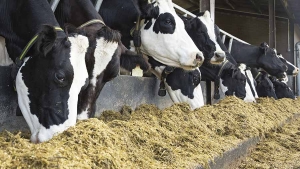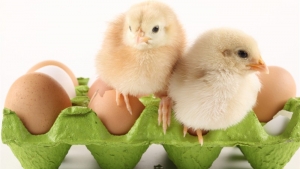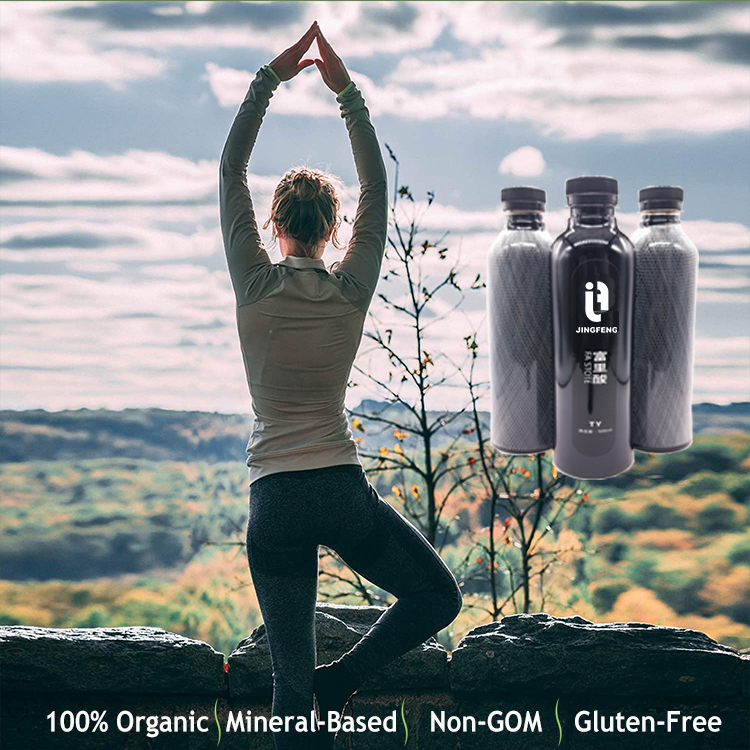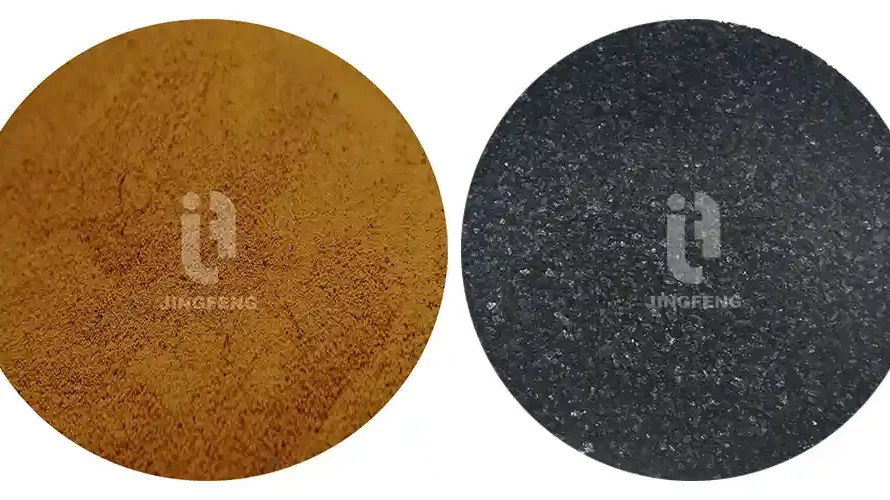The sodium humate uses in livestock feed additives is very obvious. Sodium humate is a kind of macromolecular organic weak acid sodium salt with many functions made of leonardite, peat and lignite . Its structure is relatively complex. It is known that humic acid molecule contains benzene ring, thick ring and some heterocyclic ring. Each aromatic ring is connected with bridge bond.

Aromatic ring has various functional groups, mainly carboxyl group, phenolic group, hydroxyl group, methoxy group, quinone group, etc. The content of dry basis humic acid in sodium humate is more than 70%. Which is a good veterinary medicine and feed additive for the production of green milk meat egg food.
1. Sodium humate uses in feed components.
- A. Because of its large molecular weight, sodium humate can be associated with larger particles in a certain medium. So it has colloidal properties and adsorption ability. Forms good ion exchange and catalysis. Promotes the activation and absorption of feed components.
- B. All kinds of compound molecular nutrients in feed are fully decomposed and well combined organically. Which increases Sodium humate used as feed additive for livestock gastrointestinal function and promotes protein assimilation. The permeability of animal cell membrane and protoplast was increased. The amount of water in muscle cell space and the water content of cells were increased.

- C. The adsorption of sodium humate made feed nutrients pass through the intestinal tract slowly. Enhanced the absorption and digestion time. Increased the absorption rate of nutrients. Sodium humate molecule is rich in nitrogen and has a strong absorption of amino group. It makes full use of non-protein ammonia in feed. Feed protein is transformed into muscle protein to give full play to lean meat growth potential and increase lean meat specific gravity.
- D. At the same time, sodium humate residual in intestinal tract can also absorb ammonia in feces. Which not only reduces the stench of feces. But also increases fodder efficiency by absorbing ammonia.
- E. The quinones contained in sodium humate participate in the redox process. Make metabolism exuberant. Promote cell proliferation and accelerate growth. Sodium humate can improve gastrointestinal function. Promote gastric juice secretion. Increase appetite. Promote the faster entry of nutrients into the body. Stimulate the growth of beneficial bacteria in gastrointestinal tract. Inhibit the reproduction of corrupt bacteria. Because sodium humate can promote digestion and absorption. It can make the mineral elements in feed compatibility better absorb and utilize. Give full play to the role of mineral elements and multivitamins.
2. Effect of endocrine function.
Sodium humate can stimulate the secretion of certain gland. Inhibit sympathetic nerve. Cause lethargy. Increase the time of animal body in sleep or quiet state. Decrease the body movement and visceral activity of the whole body generally. On the one hand, it is beneficial to the assimilation of the whole body.

So that the organ system can be recovered in time. On the other hand, the body temperature of livestock decreases during sleep. The heat consumption and excess exercise energy consumption decrease. Which relatively increases the storage energy.
As a result, the deposition of muscle and fat is increased and the feed conversion rate is increased. Sodium humate can activate the function of pituitary-adrenal cortex. Promote the secretion of ACTH. Increase the secretion of estrogen and stimulate the balance of thyroid gland.
3. Sodium humate uses in antibacterial and anti-inflammatory.
The sodium humate can promote the release of the corticoid and ACTH by activating the pituitary-adrenal system. Inhibit the synthesis of the prostate E. The sodium humate is a high-molecular complex and contains an alkaloid.

So that the sodium humate has strong adsorption capacity for intestinal inflammation and toxic substances, and simultaneously has a convergent effect on the intestinal mucosa of the intestinal tract. And moreover, because the sodium humate structure contains various active groups, the blood vessel can be contracted.
The permeability of the capillary is reduced, and the anti-inflammatory and hemostatic effect is achieved. Under the action of various enzymes, the active group in the sodium humate molecule can decompose more initial ecological oxygen and present a sterilization effect.
4. Sodium humate uses in wound healing.
Sodium humate can quickly form a protective membrane on the surface of trauma and contract microvessels to stop bleeding. Because the molecular structure of sodium humate determines that it is both an oxidant and a reductant. Which can separate the primary ecological oxygen and increase the internal respiration of the cell.
 Sodium humate can increase the number of platelets. Make blood vessels contract. Reduce capillary permeability. Reverse abnormal microcirculatory perfusion to promote the return to normal. Sodium humate can stimulate the synthesis of prostaglandins in gastric mucosa. Increase gastric mucosal blood flow. Protect gastric mucosa and make ulcer heal.
Sodium humate can increase the number of platelets. Make blood vessels contract. Reduce capillary permeability. Reverse abnormal microcirculatory perfusion to promote the return to normal. Sodium humate can stimulate the synthesis of prostaglandins in gastric mucosa. Increase gastric mucosal blood flow. Protect gastric mucosa and make ulcer heal.
5. Specific application
Sodium humate uses in chicken industry.
 In 1981, the application of compound livestock-and-poultry-promoting agent based on sodium humate was used to test 404-day-old laying hens. In the test group,1 g of sodium humate additive was added daily. The laying rate of the test group was 24.5% higher than that of the control group.
In 1981, the application of compound livestock-and-poultry-promoting agent based on sodium humate was used to test 404-day-old laying hens. In the test group,1 g of sodium humate additive was added daily. The laying rate of the test group was 24.5% higher than that of the control group.- The effects of sodium humate on the laying rate of laying hens, the plasma components of the chicken and the nutritional components of the eggs were studied in Haidian District, Beijing. 1016 experimental chicks were selected. And the experimental group was added 1.5% to 2% (in pure quantity) in proportion to the feed.The amount of sodium humate was 79%.
Experiment results:
1) The weight gain was 85.6 g, the weight gain was 7.6% in 80 days, and the difference was significant (P <0.01).
2) The mortality of the test group was decreased by 7.6% (P <0.05) than that of the control group (P <0.05).
3) In the test group, the egg and the start-up date were 2 to 5 days earlier than the control group. The average laying rate in the test group was 7.1% higher than that of the control group (P <0.01).
4)The feed and egg ratio of the test group was 3.06:1, the control group was 3.49:1,
5)The egg weight and the volume of the test group were compared with that of the control group. The weight of the egg white and the protein concentration were significantly higher than that of the control group.
- MR. An Wen observed the effect of adding sodium humate (79.84%) to meat chicken. 500 experimental chickens . The results showed that:
(1) The weight gain of the experimental group was 5.9 g higher than the control group, that is, 11.4 g higher than that of the control group, which indicated that the product could promote the growth and development of meat chickens to a certain extent and increase the daily weight gain.
(2) The mortality rate of the experimental group was 4.3% lower than the control group, which indicated that the product could enhance the resistance of chickens to some infectious diseases and reduce the mortality rate.
(3) Compared with the control group, the experimental group consumed 9.6% less feed per chicken, and the experimental group increased meat by 39 g, that is to say, 23% more meat than the control group.It is shown that sodium humate can reduce feed consumption, that is to say, it can increase feed reward and reduce cost.
Sodium humate uses in Pig industry.
The application of sodium humate in pig production can increase the daily growth of pigs and shorten the fattening period. From 1976 to 1978, Wang Neigui etc.tested 206 pigs from 5 pig farms and 213 pigs raised by farmers. The pigs above 50kg in the experimental group were taken 10 g per day. The pigs 15-50 kg were taken 7 g a day. And the pigs below 15 kg were fed 4 g a day for one month.

Results: the average daily gain of the experimental group was 150 – 200 g higher than that of the control group. Which could shorten the fattening period by 30 × 50 days. Pigs have a strong appetite, bright hair, ruddy skin, sleep more often, do not coax circles, do not jump walls, faeces soft, stench significantly reduced.
The advantage of the sodium humate used for pig feeding
Sodium humate and olaquindox had significant effects on fattening pigs. And generally speaking, there was no significant difference between them. Cai Dengdi etc. tested to compare the fattening pigs with sodium humate and olaquindox in May 1988.
The results showed that the weight gain efficiency of adding sodium humate and olaquindox was 22.7% and 28.9% higher than that of the control group, respectively. The comparison between the two groups: Compared with the addition of sodium humate, the average daily increase was 15 g. The weight gain rate was 5%. And the difference of 2 groups was not significant.
According to the report, the water loss rate of the pigs added with the sodium humate is improved. And the pig with the sodium humate is added. The oil content, the water content, the various trace elements, the content of the total protein in the lean meat, the examination of the blood and the liver function, the radioactivity and the like are all within the normal range. No obvious lesions were found in the disease-understanding agent of each organ.
Sodium humate uses in cow industry.
 The application practice on dairy cows has proved that the addition of a certain amount of sodium humate to the feed of dairy cows has obvious effect on improving the milk yield. In 1987, Wang Zhongxin used sodium humate as the main component of the compound RI feed. Which was tested three times in Yonghua Dairy Farm of Bahang Jin Houqi.
The application practice on dairy cows has proved that the addition of a certain amount of sodium humate to the feed of dairy cows has obvious effect on improving the milk yield. In 1987, Wang Zhongxin used sodium humate as the main component of the compound RI feed. Which was tested three times in Yonghua Dairy Farm of Bahang Jin Houqi.
The results showed that the milk yield of the experimental group was about 15% higher than that of the control group during the whole experimental period. The average daily milk gain per cow was 2.04 kg more than that of the control group. The appetite of the experimental cows were always good. Cow hair smooth and bright. The health condition was good. And there was no abnormal change.
Experiment of Sodium humate effect on cows
In 1994, Jiang Anwen et al., using sodium humate, tested 100 cows in two stages (30 days each). Each cow of the test group was added 30 kg a day, 10 kg at a time, wrapped in paper, fed directly on the feed. The milk yield was calculated before, during and after the three stage experiment. The average daily milk yield was calculated.
The results showed that compared with the control group, the daily milk gain rate of the experimental group was 1.15 kg and the daily milk increase rate was 6.75%, and the effect was very obvious.
Sodium humate used for improving the utilization of Urea
- A. Sodium humate also plays a very obvious role in buffering urine meter on cattle and improving the utilization of urea. In 1982, Wang Neigui and others carried out experiments in Jincheng dairy farm. Before the experiment, a certain amount of urea was often added to feed to improve productivity. But ammonia poisoning often occurred in the feeding process. Which limited the utilization of urea.
- B. Therefore, they use sodium humate to adsorb excessive ammonia gas decomposed by rumen microorganisms in digestion. Which not only alleviates the toxicity of urea to livestock, but also reduces the stench and improves the fertilizer efficiency of animal fertilizer. In the control group, when 60g urea was taken once a day, there was poisoning phenomenon.
- C. The experimental group with sodium humate fed 80g urea once, and there was no poisoning phenomenon. From beginning to end, each cow increased milk by 2.9 kg. The color and smell of milk produced were normal. There was no abnormal milk color, spirit, appetite and feces in the experimental group.
Sodium humate uses in sheep feeding.
The application of Cai Dengdi in sheep fattening was carried out in 1987. The effects of humic acid and olaquindox on lamb fattening were compared for 56 days. The content of humic acid was 50%. 4% per lamb per day. Mixed in a small amount of concentrate feed. 98% olaquindox powder, 0.025 g per lamb per day. Mixed in a small amount of concentrate feed.
The results showed that the average daily gain of humic acid was 16 g more than that of olaquindox, which was 49 g more than that of the control group. Especially every month, the average daily weight gain of humic acid group was 100 g. That of olaquindox group was 72 g, and that of control group was only 24 g.
Sodium humate uses in other animal feeding.
- Others, the application of sodium humate in sika deer breeding and silkworm raising has also achieved remarkable results. There is no one-by-one explanation here. In a word, sodium humate can be widely used in feeding industry. Used in laying hens, it can improve laying rate, feed reward and eggshell quality. Prevent water sample faeces and reduce fecal odour and reduce death rate. Used in meat chickens, it can increase feed reward and reduce death rate; it can be used in pig raising, which can be equivalent to quinolol, and has no drug residue, non-toxic side effects and improve meat quality. Pig appetite is strong, the skin red hair is bright, obviously reduces the fecal odour. In addition, used in herbivores (cattle, sheep, deer, etc.), are significantly increased productivity.
- According to the above discussion, sodium humate is inherently rational and participates in various metabolic activities of animal body. Sodium humate uses as feed additives have not only the same effect of the same kind of products. But also has the irreplaceable effect of other products to prevent gastrointestinal diseases. Improve the quality of animal products. Improve the production performance, and have no toxic and side effects.


 In 1981, the application of compound livestock-and-poultry-promoting agent based on sodium humate was used to test 404-day-old laying hens. In the test group,1 g of sodium humate additive was added daily. The
In 1981, the application of compound livestock-and-poultry-promoting agent based on sodium humate was used to test 404-day-old laying hens. In the test group,1 g of sodium humate additive was added daily. The 




